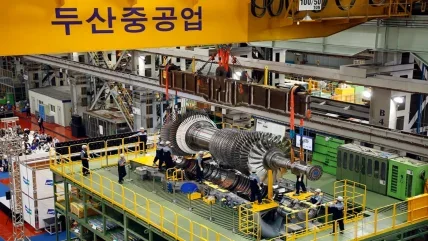
Korea is well on its way to joining the elite group of countries (USA, Germany, Japan, Italy) with their own independent advanced large-frame gas turbine and combined cycle technologies.
Most recently, on 13 July 2020, Doosan Heavy Industries & Construction announced that it had signed an MOU with Korean Western Power Co (KOWEPO) to co-operate on the “next generation Korean standard combined cycle power plant”, which will incorporate Doosan’s new large gas turbine technology, which it says it “has successfully developed on its own.”
With the signing of the July MOU, the two companies say they seek “to jointly develop a Korean standard combined cycle power plant model that is competitive both at home and abroad.” They also plan to “effectively develop the overseas markets” for the technology.
Doosan Heavy is supplying (under a December 2019 agreement) its new gas turbine to KOWEPO’s 500 MW LNG-fuelled Gimpo combined cycle CHP plant, due to enter commercial operation in 2023. This project (located at Gimpo city, Gyeonggi province) includes a two year long demonstration programme for the new machine, which will be installed at the site and started up in 2021.
Doosan is also carrying out plant construction and power block installation for Gimpo, under dual contracts with KOWEPO announced in June 2020 (valued at, respectively, 130 billion won and 230 billion won). Plant construction scope includes transmission lines and water treatment systems, while power block scope includes steam turbine, HRSG and generator.
According to the recently released 9th Basic Plan for Electricity Supply & Demand, natural gas fired generation in Korea is expected to grow dramatically, from 41.3 GW in 2020 to 60.6 GW by 2034, helped by the conversion of 24 out of 30 coal fired plants to natural gas. “Given that huge market growth is expected”, says Hongook Park, CEO of Doosan Heavy’s power service business group, Doosan aims to “leverage its industry-academia-research alliances to effectively develop a top-notch Korean standard gas-fired combined cycle power plant model.”
Doosan is a member of a task force to develop “Korean standard gas-fired combined cycle power plant”, which was launched by the Ministry of Trade, Industry and Energy in February, with a focus on LNG-based power generation. The task force is composed of players from both the private and public sectors, including companies from Korea’s gas turbine industry, such as Sung-il Turbine P&S and Korea LostWax, universities (including Seoul National, Yonsei and Inha), five power companies, and the Korea Institute of Energy Technology Evaluation and Planning (KETEP).
Development work on the new Korean gas turbine began in 2013 as a government backed national project (with support from the Ministry of Trade, Industry, and Energy (MOTIE) and KETEP), with the aim of reducing the country’s dependence on imported gas turbine technology. The government has invested about KRW 60 billion in the project, while Doosan Heavy says it has spent around KRW one trillion on R&D.
Final assembly of the new turbine, the DGT6- 300H S1, with an installed capacity of 270 MW (compressor pressure ratio 1:24 and turbine inlet temperature > 1500°C) was completed in September 2019 at Changwon, where in-house performance testing is currently underway.
In addition to this model, Doosan Heavy says it “plans to develop a follow-up gas turbine model (380 MW) with the latest specifications to pre-emptively reflect market changes”, and a 100 MW mid-sized model designed to complement the intermittency of renewables.
Doosan estimates that a total of some 149 gas turbines are currently operating in power plants in Korea, “all of which were imported” and “considering the purchase cost of about KRW 8.1 trillion and maintenance, auxiliary, and other costs of about KRW 4.2 trillion, the combined total cost of these turbines is about KRW 12.3 trillion.”
The obsolescence of current cogeneration plants and the re-powering of coal-fired power plants will require some 18 GW of new combined cycle cogen capacity to be constructed by 2030, Doosan estimates. The deployment of domestic gas turbines for all of this 18 GW of generating capacity “would be equivalent to a total import substitution effect of about 10 trillion won (based on USD 480.1 per kW and KRW 1150 per USD)”, Doosan calculates, and notes that “the advantages would be even greater if the service business (maintenance and parts replacement) and the entry into overseas markets are added to the equation.”
Doosan refers to a forecast that 432 GW of gas fuelled combined cycle capacity will be constructed worldwide between 2018 and 2028 and says “it plans to develop the gas turbine into its main line of business in a bid to generate annual sales of KRW 3 trillion and create more than 30 000 jobs by 2026 by adopting aggressive sales programmes in Korea and abroad.”
It “has steadily invested in developing its gas turbines into its main business line” and initiatives have included opening R&D centres dedicated to the development of large gas turbines for power generation, in Changwon, as well as in Florida and Baden, Switzerland, and construction of a full speed, full load test centre (with more than 3000 sensors fitted to the turbine under test) in Changwon, representing an investment of more than KRW 100 billion.
Doosan Heavy says it has “also been preparing to penetrate the gas turbine service market”, noting that “gas turbine manufacturers have continuously created post-supply income from the service business, which encompasses maintenance and parts replacement.” In 2017 it acquired ACT Independent Turbo Services (based in La Porte, Texas), now called Doosan Turbomachinery Services (DTS). DTS “has the know-how to service most gas turbine models currently in commercial operation in Korea”, observes Doosan.






